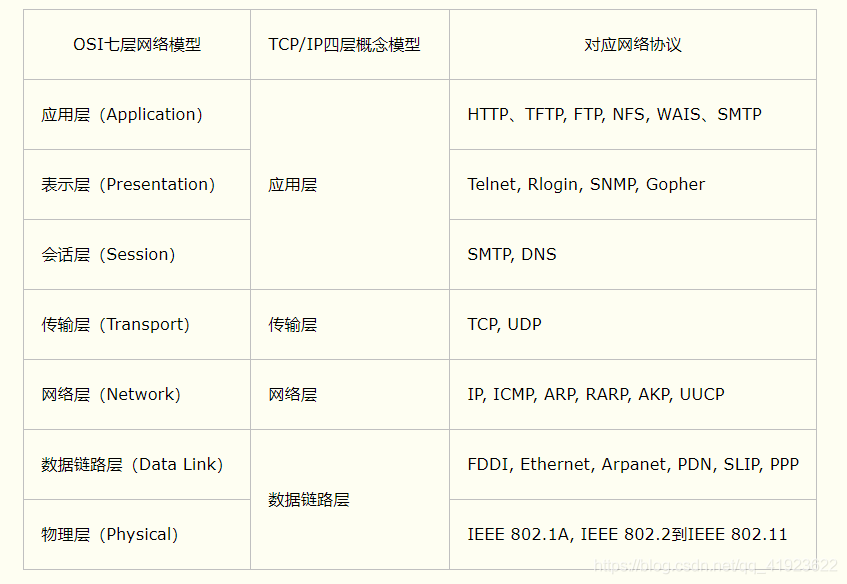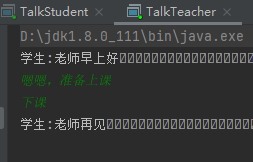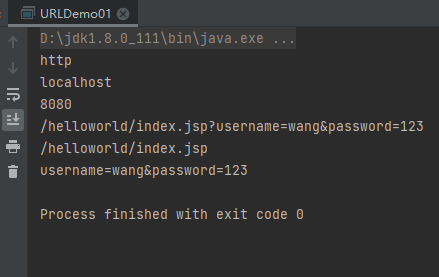04-网络编程
网络编程
1 概述
计算机网络:将地理位置不同的具有独立功能的多台计算机及其外部设备,通过通信线路连接起来,在网络操作系统,网络管理软件及网络通信协议的管理和协调下,实现资源共享和信息传递的计算机系统。
网络编程的目的:传播交流信息,数据交换,通信
想要达到这个效果需要什么:
- 如何准确的定位网络上的一台主机 ping
- 找到这个主机如何传输数据
javaweb:网页编程 B/S
网络编程:TCP/IP C/S
2 网络通信的要素
如何实现网络的通信?
通信双方的地址:
- ip
- 端口号
规则:网络通信协议
TCP/IP参考模型:

3 IP
ip地址:InetAddress
- 唯一定位一台网络上的计算机
- 127.0.0.1:本机 localhost
- ip地址的分类
- IPV4:127.0.0.1,4个字节组成,0~255,42亿;30亿都在北美,亚洲4亿。2011年就用尽了
- IPV6:fe80::4cf0:769c:2d4b:77fa%21,128位,8个无符号整数
- 公网(互联网)——私网(局域网)
- ABCD类地址
- 192.168.xx.xx,专门给组织内部使用的
- 域名
import java.net.InetAddress;
import java.net.UnknownHostException;
//测试IP
public class TestInetAddress {
public static void main(String[] args) {
try {
//查询本机地址
InetAddress inetAddress1 = InetAddress.getByName("127.0.0.1");
System.out.println(inetAddress1);
InetAddress inetAddress3 = InetAddress.getByName("localhost");
System.out.println(inetAddress3);
InetAddress inetAddress4 = InetAddress.getLocalHost();
System.out.println(inetAddress4);
//查询网站ip地址
InetAddress inetAddress2 = InetAddress.getByName("www.baidu.com");
System.out.println(inetAddress2);
//常用方法
//System.out.println(inetAddress2.getAddress());
System.out.println(inetAddress2.getCanonicalHostName());//规范的名字
System.out.println(inetAddress2.getHostAddress());//ip
System.out.println(inetAddress2.getHostName() );//域名,或者自己电脑的名字
} catch (UnknownHostException e) {
e.printStackTrace();
}
}
}
4 端口
端口表示计算机上的一个程序的进程;
-
不同的进程有不同的端口号!用来区分软件!
-
被规定 0~65535
-
TCP,UDP:65535*2 单个协议下,端口号不能冲突
-
端口分类
- 公有端口 0~1023
- HTTP:80
- HTTPS:443
- FTP:21
- Telent:23
- 程序注册端口:1024~49151,分配用户或者程序
- Tomcat:8080
- MySQL:3306
- Oracel:1521
- 动态、私有:49152~65535(尽量别用)
netstat -ano #查看所有的端口 netstat -ano|findstr "5900" #查看指定的端口 tasklist|findstr "8696" #查看指定端口的进程 ctrl+shift+esc 打开任务管理器import java.net.InetSocketAddress; public class TestInetSocketAddress { public static void main(String[] args) { InetSocketAddress socketAddress = new InetSocketAddress("127.0.0.1", 8080); InetSocketAddress socketAddress1 = new InetSocketAddress("localhost", 8080); System.out.println(socketAddress); System.out.println(socketAddress1); System.out.println(socketAddress.getAddress()); System.out.println(socketAddress.getHostName());//地址 System.out.println(socketAddress.getPort());//端口 } } - 公有端口 0~1023
5 通信协议
网络通信协议:速率,传输码率,代码结构,传输控制......
大事化小:分层
TCP/IP协议簇:实际上是一组协议,
- TCP:用户传输协议
- UDP:用户数据报协议
- IP:网络互连协议
tcp udp对比
TCP:打电话
- 连接,稳定
- 三次握手,四次挥手
- 客户端、服务端
- 传输完成,释放连接,效率低
UDP:发短信
- 不连接,不稳定
- 客户端、服务端:没有明显界限
- 不管有没有准备好,都可以发给你
- 导弹
- DDOS:洪水攻击(饱和攻击)
6 TCP
客户端:1.连接服务器Socket;2.发送消息
服务端:1.建立服务的端口ServerSocket;2.等待用户的连接 accept;3.接收用户的消息
import java.io.IOException;
import java.io.OutputStream;
import java.net.InetAddress;
import java.net.Socket;
//客户端
public class TcpClientDemo01 {
public static void main(String[] args) {
Socket socket = null;
OutputStream os=null;
try {
//1.要知道服务器的地址
InetAddress serverIP = InetAddress.getByName("127.0.0.1");
int port=9999;
//2.端口号
socket = new Socket(serverIP,port);
//3.发送消息 IO流
os = socket.getOutputStream();
os.write("Hello,World".getBytes());
} catch (Exception e) {
e.printStackTrace();
}finally {
if(os!=null){
try{
os.close();
} catch (IOException e) {
e.printStackTrace();
}
}
if(socket!=null){
try{
socket.close();
} catch (IOException e) {
e.printStackTrace();
}
}
}
}
}
import java.io.ByteArrayOutputStream;
import java.io.IOException;
import java.io.InputStream;
import java.net.ServerSocket;
import java.net.Socket;
//服务器
public class TcpServerDemo01 {
public static void main(String[] args) throws IOException {
ServerSocket serverSocket = null;
Socket socket=null;
InputStream is =null;
ByteArrayOutputStream baos = null;
try {
//1.我得有一个地址
serverSocket = new ServerSocket(9999);
while (true){
//2.等待客户端连接过来
socket = serverSocket.accept();
//3.读取客户端的消息
is = socket.getInputStream();
//管道流
baos = new ByteArrayOutputStream();
byte[] buffer = new byte[1024];
int len;
while ((len = is.read(buffer)) != -1) {
baos.write(buffer, 0, len);
}
System.out.println(baos.toString());
}
/*
byte[] buffer = new byte[1024];
int len;
while ((len=is.read(buffer))!=-1){
String s = new String(buffer,0,len);
System.out.println(s);
}
*/
}catch (IOException e){
e.printStackTrace();
}finally {
//关闭资源
if(baos!=null){
try {
baos.close();
}catch (IOException e){
e.printStackTrace();
}
}
if (is!=null){
try{
is.close();
}catch (IOException e){
e.printStackTrace();
}
}
if(socket!=null){
try{
socket.close();
} catch (IOException e) {
e.printStackTrace();
}
}
if(serverSocket!=null){
try {
serverSocket.close();
} catch (IOException e) {
e.printStackTrace();
}
}
}
}
}
文件上传
服务器端:
import java.io.FileOutputStream;
import java.io.IOException;
import java.io.InputStream;
import java.io.OutputStream;
import java.net.ServerSocket;
import java.net.Socket;
public class TcpServerDemo02 {
public static void main(String[] args) throws IOException {
//1.创建服务
ServerSocket serverSocket = new ServerSocket(9000);
//2.监听客户端的连接
Socket socket = serverSocket.accept();//阻塞式监听,会一直等待客户端连接
// 3.获取输入流
InputStream is = socket.getInputStream();
//4.文件输出
FileOutputStream fos = new FileOutputStream("receive");
byte[] buffer = new byte[1024];
int len;
while ((len=is.read(buffer))!=-1){
fos.write(buffer,0,len);
}
//通知客户端接收完毕了
OutputStream os = socket.getOutputStream();
os.write("我接收完毕了,你可以断开了".getBytes());
//关闭资源
fos.close();
is.close();
socket.close();
serverSocket.close();
}
}
客户端:
import java.io.*;
import java.net.InetAddress;
import java.net.Socket;
public class TcpClientDemo02 {
public static void main(String[] args) throws IOException {
//1.创建一个Socket连接
Socket socket = new Socket(InetAddress.getByName("127.0.0.1"), 9000);
//2.创建一个输出流
OutputStream os = socket.getOutputStream();
//3.读取文件
FileInputStream fis = new FileInputStream(new File("happy.gif"));
//4.写出文件
byte[] buffer = new byte[1024];
int len;
while ((len=fis.read(buffer))!=-1){
os.write(buffer,0,len);
}
//通知服务器,我已经结束了
socket.shutdownOutput();//我已经传输完了
//确定服务器接收完毕才能够断开连接
InputStream inputStream = socket.getInputStream();
ByteArrayOutputStream baos = new ByteArrayOutputStream();
byte[] buffer2 = new byte[2014];
int len2;
while ((len2=inputStream.read(buffer2))!=-1){
baos.write(buffer2,0,len2);
}
System.out.println(baos.toString());
//5.关闭资源
baos.close();
inputStream.close();
fis.close();
os.close();
socket.close();
}
}
Tomcat
服务端
- 自定义 S
- Tomcat服务器 S:java后台开发
客户端
- 自定义 C
- 浏览器 B
7 UDP
发短信:不用连接,需要知道对方的地址
发送消息
import java.io.IOException;
import java.net.*;
//不需要连接服务器
public class UdpClientDemo01 {
public static void main(String[] args) throws IOException {
//1.建立一个Socket
DatagramSocket socket = new DatagramSocket();
//2.建个包
String msg = "你好,服务器";
//发送给谁
InetAddress localhost = InetAddress.getByName("localhost");
int port = 9090;
//数据,数据的长度起始,要发送给谁
DatagramPacket packet = new DatagramPacket(msg.getBytes(), msg.getBytes().length, localhost, port);
//3.发送包
socket.send(packet);
//4.关闭流
socket.close();
}
}
接收端:
import java.io.IOException;
import java.net.DatagramPacket;
import java.net.DatagramSocket;
//还是要等待客户端的连接
public class UdpServerDemo01 {
public static void main(String[] args) throws IOException {
//开放端口
DatagramSocket socket = new DatagramSocket(9090);
//接收数据包
byte[] buffer = new byte[1024];
DatagramPacket packet = new DatagramPacket(buffer, 0, buffer.length);//接收
socket.receive(packet);//阻塞接收
System.out.println(packet.getAddress().getHostAddress());
System.out.println(new String(packet.getData(),0,packet.getLength()));
//关闭连接
socket.close();
}
}
循环发送消息
import java.io.BufferedReader;
import java.io.IOException;
import java.io.InputStreamReader;
import java.net.DatagramPacket;
import java.net.DatagramSocket;
import java.net.InetSocketAddress;
public class UdpSenderDemo01 {
public static void main(String[] args) throws IOException {
DatagramSocket socket = new DatagramSocket(8888);
//准备数据:控制台读取System.in
BufferedReader reader = new BufferedReader(new InputStreamReader(System.in));
while (true){
String data = reader.readLine();
byte[] datas = data.getBytes();
DatagramPacket packet = new DatagramPacket(datas, 0, datas.length, new InetSocketAddress("localhost", 6666));
socket.send(packet);
if (data.equals("bye")){
break;
}
}
socket.close();
}
}
接收端:
import java.io.IOException;
import java.net.DatagramPacket;
import java.net.DatagramSocket;
public class UdpReceiveDemo01 {
public static void main(String[] args) throws IOException {
DatagramSocket socket = new DatagramSocket(6666);
while (true) {
//准备接收包裹
byte[] container = new byte[1024];
DatagramPacket packet = new DatagramPacket(container, 0, container.length);
socket.receive(packet);//阻塞式接收包裹
//断开连接 bye
byte[] data = packet.getData();
String s = new String(data, 0, data.length);
System.out.println(s);
if(s.equals("bye")){
break;
}
}
socket.close();
}
}
咨询
双方都可以是发送方与接收端。
服务器:
import java.io.BufferedReader;
import java.io.IOException;
import java.io.InputStreamReader;
import java.net.DatagramPacket;
import java.net.DatagramSocket;
import java.net.InetSocketAddress;
public class TalkSend implements Runnable{
DatagramSocket socket=null;
BufferedReader reader=null;
private int fromPort;
private String toIP;
private int toPort;
public TalkSend(int fromPort, String toIP, int toPort) {
this.fromPort = fromPort;
this.toIP = toIP;
this.toPort = toPort;
try{
socket = new DatagramSocket(fromPort);
reader = new BufferedReader(new InputStreamReader(System.in));
} catch (IOException e) {
e.printStackTrace();
}
}
@Override
public void run() {
while (true){
try{
String data = reader.readLine();
byte[] datas = data.getBytes();
DatagramPacket packet = new DatagramPacket(datas, 0, datas.length, new InetSocketAddress(this.toIP,this.toPort));
socket.send(packet);
if (data.equals("bye")){
break;
}
} catch (IOException e) {
e.printStackTrace();
}
}
socket.close();
}
}
import java.io.IOException;
import java.net.DatagramPacket;
import java.net.DatagramSocket;
public class TalkReceive implements Runnable{
DatagramSocket socket = null;
private int port;
private String msgFrom;
public TalkReceive(int port, String msgFrom) {
this.port = port;
this.msgFrom = msgFrom;
try {
socket = new DatagramSocket(port);
} catch (IOException e) {
e.printStackTrace();
}
}
@Override
public void run() {
while (true) {
try {
//准备接收包裹
byte[] container = new byte[1024];
DatagramPacket packet = new DatagramPacket(container, 0, container.length);
socket.receive(packet);//阻塞式接收包裹
//断开连接 bye
byte[] data = packet.getData();
String s = new String(data, 0, data.length);
System.out.println(msgFrom+":"+s);
if(s.equals("bye")){
break;
}
} catch (IOException e) {
e.printStackTrace();
}
}
socket.close();
}
}
客户端:
public class TalkTeacher {
public static void main(String[] args) {
new Thread(new TalkSend(5555,"localhost",8888)).start();
new Thread(new TalkReceive(9999, "学生")).start();
}
}
public class TalkStudent {
public static void main(String[] args) {
//开启两个线程
new Thread(new TalkSend(7777,"localhost",9999)).start();
new Thread(new TalkReceive(8888,"老师")).start();
}
}


8 URL
统一资源定位符:定位互联网上的某一个资源。
DNS域名服务器 www.baidu.com xxx.x..x..x
URL由五部分组成:
协议://ip地址:端口/项目名/资源
import java.net.MalformedURLException;
import java.net.URL;
public class URLDemo01 {
public static void main(String[] args) throws MalformedURLException {
URL url = new URL("http://localhost:8080/helloworld/index.jsp?username=wang&password=123");
System.out.println(url.getProtocol());//协议
System.out.println(url.getHost());//主机ip
System.out.println(url.getPort());//端口
System.out.println(url.getFile());//全路径
System.out.println(url.getPath());//文件
System.out.println(url.getQuery());//参数
}
}

import java.io.FileOutputStream;
import java.io.IOException;
import java.io.InputStream;
import java.net.HttpURLConnection;
import java.net.URL;
public class UrlDown {
public static void main(String[] args) throws IOException {
//1.下载地址
URL url = new URL("http://localhost:8080/wang/password.txt");
//2.连接到这个资源 HTTP
HttpURLConnection urlConnection = (HttpURLConnection) url.openConnection();
InputStream inputStream = urlConnection.getInputStream();
FileOutputStream fos = new FileOutputStream("password.txt");
byte[] buffer = new byte[1024];
int len;
while ((len=inputStream.read(buffer))!=-1){
fos.write(buffer,0,len);//写出这个数据
}
fos.close();
inputStream.close();
urlConnection.disconnect();
}
}
通过Java中的URL类进行简单的网络资源的爬取。


 浙公网安备 33010602011771号
浙公网安备 33010602011771号